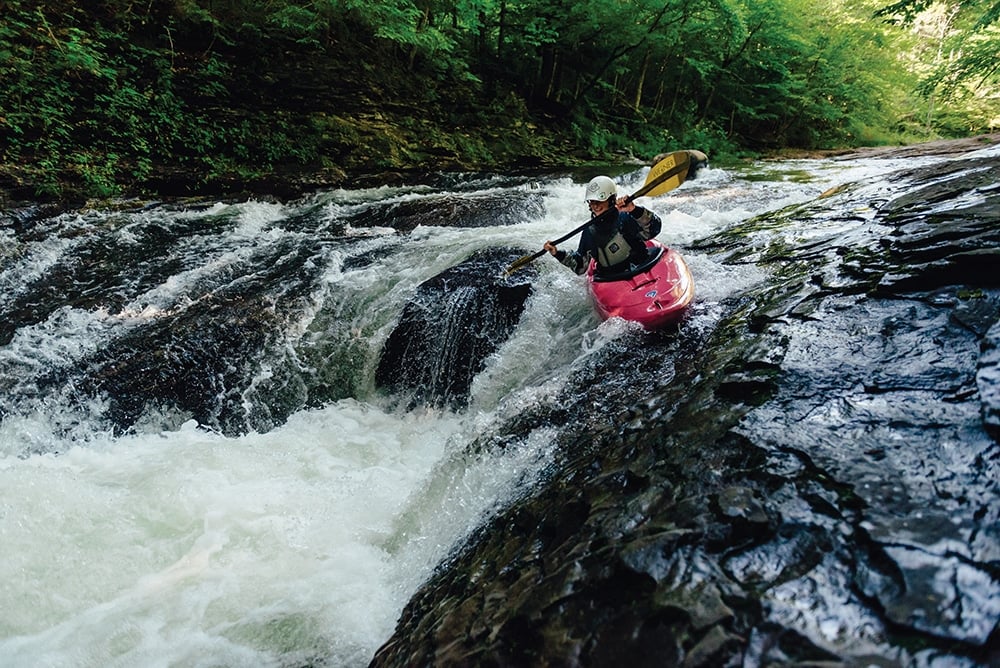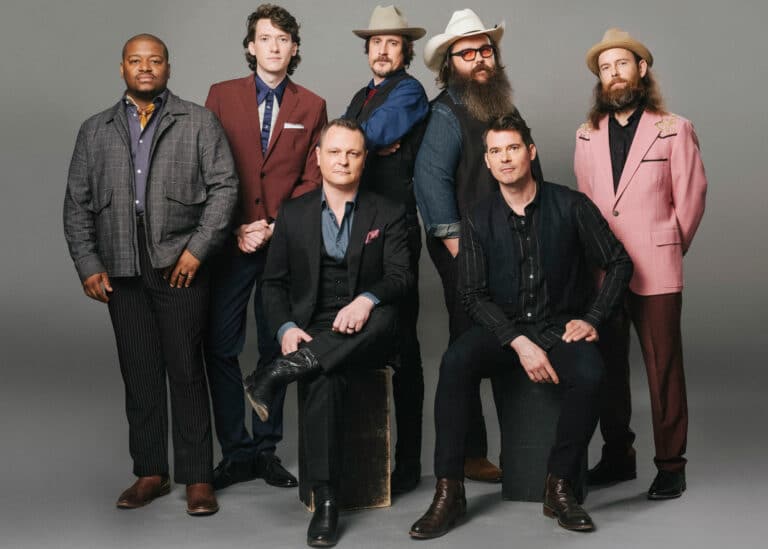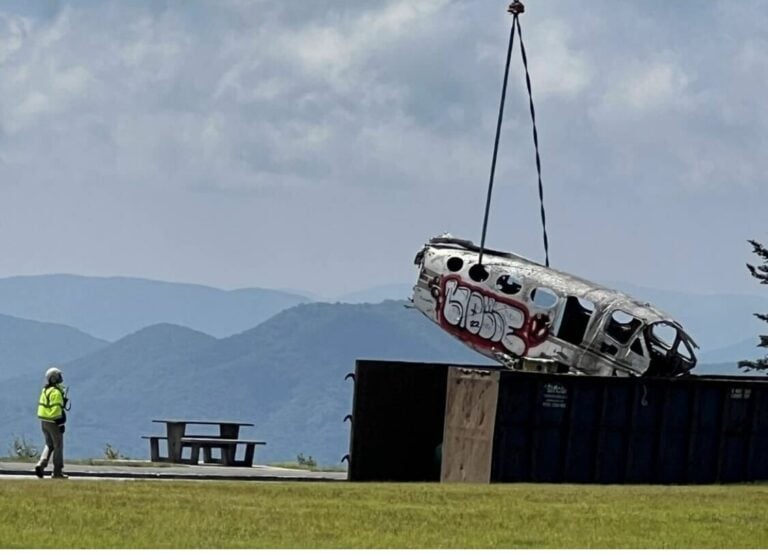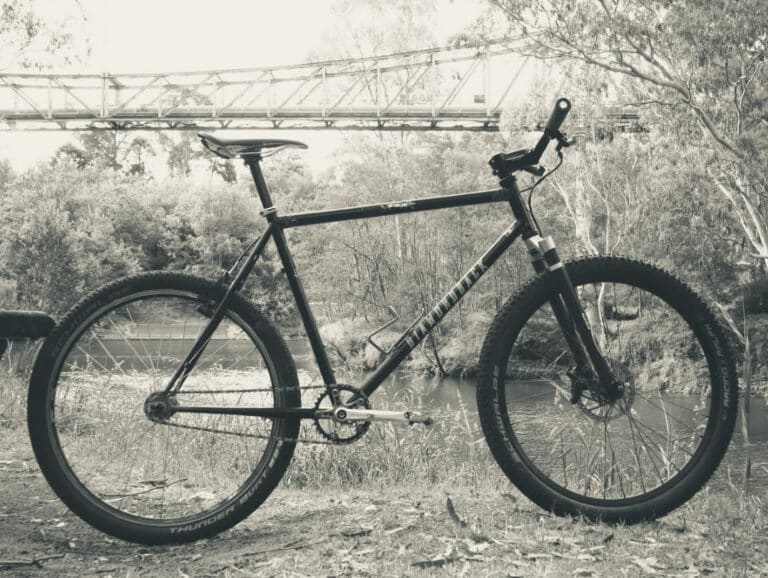As summer heats up, there’s no better way to cool down than exploring the waters of the Blue Ridge. With increased access to the outdoors hopefully on the horizon, we’ve rounded up some of the most exciting and unique paddling spots in the Mid-Atlantic and Southeast. From extreme whitewater rapids to calm and peaceful lakes, we’ve provided plenty of options to inspire your future water adventures.
Raging Rivers
Big Water on West Virginia’s Blackwater River
When kayakers first started paddling the Blackwater in the mid-80s, John Regan was one of the first down the river. “There were very few people paddling hard whitewater, let alone the Blackwater,” he said. “Back then it was a way different ballgame than it is nowadays. When I was first running the Blackwater, we were paddling boats we made out of fiberglass and composites.”
In November 1985, huge rainstorms and major flooding caused by remnants of Hurricane Juan swept through the Mid-Atlantic and changed the river forever. “Before the flood, the handful of folks that were on the river then were the only ones that ever paddled that river,” Regan said. “In that spring of 1986 when we went back, it was like exploring a whole new river again. It was in the same canyon and had the same gradient, but it definitely had different features.”
The Upper Blackwater starts below the falls at Blackwater Falls State Park. This two-mile run is chock full of Class IV and V rapids as the river drops 250 feet per mile. The Lower Blackwater starts at the North Fork Confluence where the river widens up. You’ll still see some big drops and solid whitewater for the next seven miles until the river peters out to Class II. Paddlers who regularly run the Blackwater recommend doing all nine miles together to avoid the painful straight uphill climb out of the river at the confluence.
Best Stretches: Although there are a lot of memorable rapids on the Blackwater, Regan particularly enjoys My Nerves Are Shot And I Can’t Take It Anymore, a three-part Class V near the end of the Upper. “It’s where the river changes from a boulder, ledgy riverbed to bedrock,” he said. “It slides, it’s really fast, accelerates, and has a really good kicker launching into the second part of the slide. It’s super dynamic and a super pretty rapid up against the right wall.”
He also stressed boaters should be prepared before paddling the Blackwater. “It’s not a forgiving place,” Regan said. “There have been some deaths on the river, and the rescue squad has been called on multiple occasions. Respect the difficulty and the wilderness aspect of this run.”
Beyond the challenging Class V whitewater, paddlers also experience the beauty of the high alpine forest of the Canaan Valley as the river drops into Blackwater Canyon, showing off the mountain laurel, rhododendron, and tannic water. Art Barket paddles the Blackwater every chance he gets. When it rains, he’s checking the levels, usually between 250-550 cfs, and putting his crew together.
“It’s an epic experience every time we go,” Barket said. “Right off the bat, it starts out intense. Right away, you have to make a ferry into 100 Yard Dash, which is one of the harder rapids on the run. You have those butterflies when you put on. After you get through that rapid, you can kind of calm down. The river eases for a while before it ramps up in the heart of it.”
Barket said first timers, even experienced paddlers, should always go with someone who knows the river. “Many of the rapids have different pathways that lead to undercuts and sieves if you go the wrong way,” he said. “You need a good knowledge of the river. There are a lot of dangerous obstacles, but there are also clean lines through all the rapids.”
Before You Go: All paddlers must register with the state park in case of emergency. Blackwater Falls is off limits and running the falls will jeopardize access for all paddlers.
Stunning Scenery and Whitewater Variety on Tennessee’s Caney Fork
Whether you’re looking to park and play, run some Class II-IV rapids, or go for a peaceful extended paddle, the Caney Fork River has something for everyone. Mack O’Rear, a self-described 19-year-old in a 72-year-old’s body, didn’t start paddling until he was in his 50s. After getting involved with the Tennessee Valley Canoe Club, he started making trips out to the Caney Fork at Rock Island State Park.
“I was born in Tennessee, traveled through Tennessee, did a lot of outdoor stuff in Tennessee, and I’ve never seen anything quite like Rock Island,” he said. “It’s just phenomenal. It’s this beautiful river gorge, almost like the Grand Canyon through there. There’s this massive, unbelievable waterfall like something you’d see in Costa Rica and Hawaii.”
Best Stretches: Putting in at the Twin Falls Overlook, it’s less than a half-mile paddle to the play wave at the base of Twin Falls. “A lot of paddlers don’t appreciate it because they’re used to going on these four- or five-mile whitewater trips,” O’Rear said. “But there’s about a mile stretch of unbelievable waterfalls and gradients. Picture the most beautiful wave you’ve ever seen in Hawaii, and it never ends. It just runs constantly. Playboaters love it in their technical boats nowadays, doing spins, flips, tricks, and surfing that wave.”
Rock Island attracts boaters of all abilities, including world champion kayaker Eric Jackson and his family of pro paddlers, who established their home base near Rock Island. Depending on the number of generators running upstream at the dam, paddlers will see a variety of levels at the wave.
“A misconception of Rock Island is they think you’ve got to be Eric Jackson level, jump in at 3,500 cfs, and get your butt handed to you on a silver platter,” O’Rear said. “It’s sweet, gentle surf at 1,800, hardcore at 3,500, but it can go up to 50,000.”
As the river flows northwest through Tennessee, there is some excellent flatwater paddling behind the Center Hill Dam. Andrea White, the Tennessee State Director for the American Canoe Association, said the Caney Fork is more than a playboater’s paradise. “There’s a new access [point] at Big Bottom [in White County],” she said. “Just some gorgeous paddling back there if you just want a really casual, flatwater paddle that doesn’t really take any kind of experience or skill.”
And it tends to run at a consistent level. “The Caney is one of the only places in the summer that has a dam release river for casual paddlers,” White said. “When the other rivers dry up during the summer, it still has water.”
Before you go: Watch the dam release schedule before you visit Rock Island. There’s a significant difference between 3,000 cfs and 12,000 cfs in how much water is processing past a single point. “They’ve had a number of swiftwater rescues there lately because there’s so much water,” White said. “I really encourage people to wear their lifejackets, even if it’s just a casual summer day.”
The Yough: ‘A Creek Learner’s Paradise’
The Youghiogheny River snakes its way through West Virginia, Maryland, and Pennsylvania, offering variety for paddlers of all levels in each of its sections. “The middle is laid-back, a lot more of a scenic tour out there,” said Andy Hiss, who’s been guiding on the river with Laurel Highlands since 1998. “The Lower Yough is a great step up. You get to start to run a lot of the moves you’re going to make on the Upper. Then the Upper Yough is everything whitewater.”
Hiss prefers the Yough to better known whitewater rivers like the Gauley in West Virginia because of the range of options. The lower section offers some good holes and waves to park and play. When water levels get low, it’s a great spot to practice your attaining, a reason it became the site for the annual Upstream World Championships.
“The Upper Yough, with its flowing waters, is just a creek learner’s paradise,” Hiss said. “When it gets higher, it gets a little sketchy and gets your heart running a little bit. If you’ve got the Upper Yough dialed in, you’re good to go for a lot of creeks out there, like Big Sandy.”
Best Stretches: Paddlers hit the Yough for beloved rapids like National Falls, Dimple Rock, and Entrance Rapid.
Before you go: “Mind the etiquette out there,” Hiss said. “If you know people are racing down through and you’re taking your time, give them a moment while they pass by. And vice versa. If you’re racing, slow up or run a different line to not mess with the newbie that’s already overwhelmed with all of the different moves they’re expected to learn eventually.”
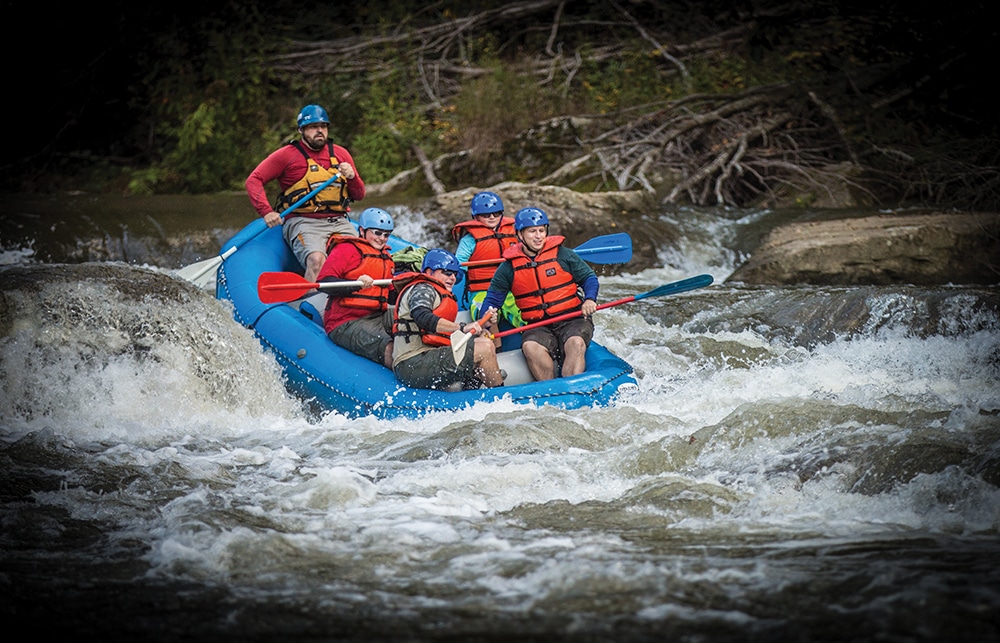
Raging Rapids on the Russell Fork
The rugged Russell Fork River, located in the primitive country on the southwest Virginia/eastern Kentucky border, is best known among paddlers for the Class V craziness that comes via dam releases every October, culminating with the annual Lord of the Fork race. But Jason Foley, who’s been paddling the Russell Fork for almost two decades, first as a kayaker and later as the owner of Kentucky Whitewater, says the river isn’t just for experts.
“Even though the Russell Fork has this reputation where folks should really watch themselves, there’s really more options out there,” he said. “The Russell Fork has different personalities at different levels.”
Winter and spring are the river’s high-level seasons for more experienced paddlers, but in the summer it caters to a broader range of skill levels, when water levels get significantly lower. The river’s different sections also have their own distinct features. The upper section starts in Virginia as a wild river with a dam on the other end. From there, the river runs through the Russell Fork Gorge and Breaks Canyon with some Class III and V sections.
Best Stretches: Foley is a big fan of El Horendo, a visibly impressive Class V rapid in the Gorge section. “It cascades into several drops over about 25 feet of verticality,” he said. “You have to make some moves in there. You have to actually maneuver and navigate through the rapid.”
The river also passes by Breaks Interstate Park on the state border. “Breaks is probably one of the hidden gems as far as outdoor recreation and parks,” Foley said. “It’s out in the middle of nowhere and you have to really be making that your destination. It is such a beautiful place. I can’t even explain how great Breaks is.”
The park includes hiking and biking trails, a zipline with views of the gorge, and rock climbing. If you’re looking for a calmer paddle, check out the pedal boat and canoe rentals on Lake Laurel.
Before you go: Check the water levels before paddling the Russell Fork. “With the recent rains we’ve had, it’s running at 4,000 cfs, which is the upper end of what anybody has ever ran it,” said Foley. “It would be difficult to even get to a bank at this flow.”

Flatwater Fun
Low Country Splendor on Lake Marion and Lake Moultrie
Bald Cypress swamps and island beaches characterize the scenery surrounding South Carolina’s Lake Marion and Lake Moultrie. Bordered by national and state parks and forests, in addition to a few wildlife management areas, and connected by a canal, the lakes are surrounded by bald eagles, white-tailed deer, dense forests, and fields of aquatic flowers.
Best Stretches: Ed Deal, owner and guide for Blueway Adventures, recommends Sparkleberry Swamp on the western end of Lake Marion. This 16,000-acre flooded forest is full of hidden creeks and wildlife in a remote wilderness. “The population here isn’t what the Charleston population is, so we don’t get the big crowds,” Deal said. “If you want some alone time, this is a good place to come.”
The calm and shallow waters are perfect for beginner and casual paddlers looking for a new spot to explore. “Most of the places are four feet deep or less, which makes for a great paddling experience because you don’t have to deal with currents and waves,” Deal said.
For further exploration of the area, try the watershed’s numerous other waterways, including the Congaree, Santee, and Cooper Rivers and Wadboo, Quinby, and Huger Creeks.
Paddlers looking for a multi-day trip can try the Swamp Fox Canoe & Camping Trail,whichruns 50 miles through both lakes. With five camping spots located on the route, you can get in a week of paddle-filled days and nights around the campfire. Longer paddling trails like this are becoming more popular across the Blue Ridge (see sidebar).
Before you go: When planning a long-distance paddling trip, make sure to research weather and water conditions before you go. Plot your camping spots and places you might need to portage.
Relaxed Exploration on Philpott Lake
Having lived in Franklin County, Va., her entire life, Robin Davis has long considered Philpott Lake a local treasure. During the summer, her family would spend their days swimming in the lake and camping by the water. “We didn’t have fancy trips to the beach,” she said. “That was our go-to place on the weekend because we could be there within 45 minutes.”
Davis fell in love with the lake all over again when she and her husband picked up paddling. “The beauty of it is you just get in your boat and start paddling,” she said. “It’s very relaxing. For a day trip, you can’t beat it.”
Philpott Lake is a 2,880-acre reservoir controlled by the Army Corps of Engineers for flood control and power generation. Without any residential houses on the shoreline, it’s a peaceful escape about an hour outside of Roanoke that can be accessed by one of several boat ramps around the lake. For overnight trips, many campgrounds dot the Philpott shoreline, while a more primitive option is Deer Island, a paddle-in only campsite.
Best Stretches: One of Davis’s favorite spots is Calico Rocks, a 200-foot cliff you can view from an inlet where cellphones don’t work. “It’s just beautiful, all the little coves you can go in and be off of the main channel,” Davis said. “There’s not a lot of traffic on it because people can’t live there. It’s preserved. You can go for however long you want to and maybe not even see anybody.”
Those looking for faster water can put in at the base of Philpott Dam and paddle the Smith River to Bassett or access more outdoor adventures at nearby Fairy Stone State Park.
Before you go: This is a big lake with much to explore. Pack enough water and food to keep energy levels up while out in the sun, and also bring sunscreen to avoid a burn on the exposed sections.
Rare Landscapes at North Carolina’s Merchants Millpond State Park
Merchants Millpond State Park holds one of North Carolina’s rarest landscapes, where paddlers can glide among towering Cypress and Gum trees covered in Spanish Moss.
“It’s a totally different environment,” said Kevin Fonda of Adventure Kayak Tours. “Instead of just being on a river traveling down, you kind of just wander around the forest. You can come around the corner and run into an alligator floating or whitetail deer out there in the middle of the millpond. All kinds of turtles, snakes, butterflies. It’s really pretty scenery, especially in the summer when it looks like a jungle or the fall when the leaves change over.”
Visitors shouldn’t let the idea of paddling with alligators scare them away from this gem. “Alligators are just like every other reptile,” Fonda said. “They don’t want anything to do with people. I’ve been there over 70 times and I’ve only seen an alligator twice. People have this misconception that it’s like south Florida.”
Best Stretches: Stick to the front by the visitor’s center or follow the water trail through the woods. Take advantage of the campsites, including some paddle-in only sites, for an extended trip. Canoe rentals are available on site if you don’t want to haul a boat with you.
Before you go: Although it’s only a 750-acre millpond, it features a maze of forest, making it easy to get lost. Consider packing a GPS to help you navigate.
Paddle the Palisades on the Kentucky River
The Kentucky River—a wide and scenic 260-mile tributary of the Ohio—offers calm and serene paddling options with consistent water throughout the summer. The river winds into remote sections of the mountains and the Daniel Boone National Forest, but it also meanders past Kentucky’s capitol with a stretch through downtown Frankfort.
Best Stretches: Stunning scenery awaits in the Kentucky Palisades, a majestic 100-mile section of the Kentucky River that features a meandering stretch of steep cliffs, deep gorges, limestone ledges, and tucked-away caves.
Before you go: Contact Canoe Kentucky (canoeky.com) for more information on put-ins, guided trips, and boat rentals.
Paddling Trails in the Blue Ridge
A growing number of paddling trails, like the 50-mile Swamp Fox Canoe & Camping Trail in South Carolina, are being developed in the Southeast.
“Counties and cities are not just thinking of the greenways and trails like back in the day,” said Deidre Hewitt, a regional program manager for the National Parks Service’s Rivers, Trails, and Conservation Assistance Program, which is supporting community-led conservation and outdoor recreation projects across the country. “[They’re saying] ‘We have a river. Can we bring people to the river? We have this great marsh system or creeks that have high water. Can we figure out if we can connect those?’”
With efforts additionally assisted by state and local partners to create maps, add signage, and develop camping spots for the route, a number of new projects are being developed, including the Southeast Coast Saltwater Paddling Trail, an 800-mile trail up the coast from Georgia to North Carolina through a series of connecting waterways; the Neuse River Blueway Plan, also an alternate route to the Mountains-to-Sea Trail in North Carolina; and Tennessee RiverLine, a 652-mile continuous route along the Tennessee River for paddlers, hikers, and bikers.
“It’s beginning to become a big trend because not everybody can get to a lake,” Hewitt said. “I think that’s a great idea to show people in urban areas that would not think to go out in the woods to experience that. It’s something fun, quick, and it’s not like you have to be out all day on the water. I think those opportunities have gotten a lot more interest in drawing people to see their resources.”
Cover Photo: Rock Run in Ralston, Pennsylvania. Photo by Scott Martin
